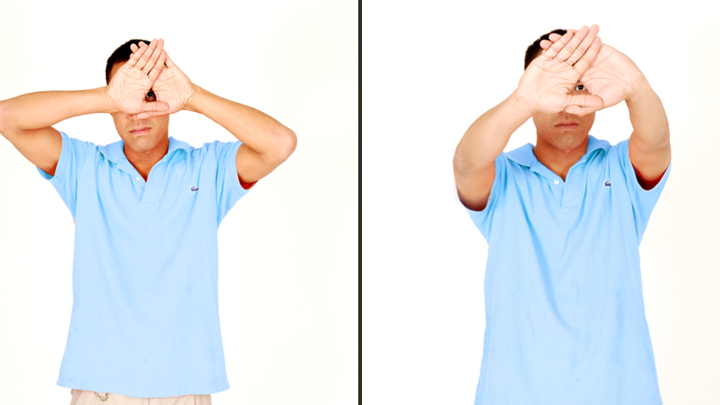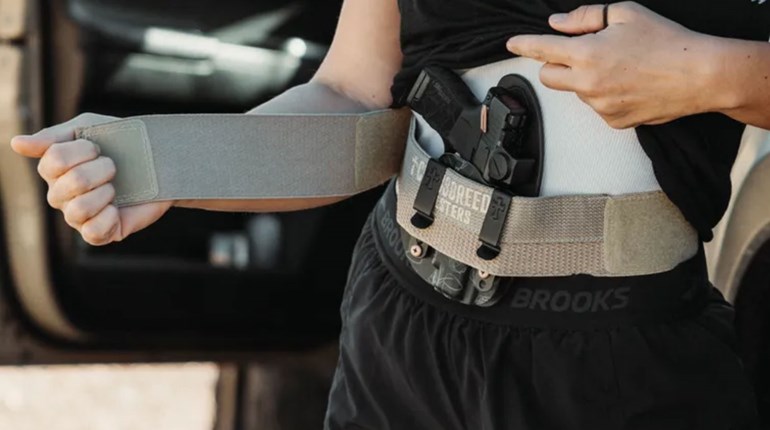
Unless you are one of those rare people who is ambidextrous (less than 1 percent of the world’s population truly is), chances are you have a dominant hand. Most of us are right handed, but about 15 percent of the world is left handed. Whichever hand you use, you also have a dominant eye, and it’s not always the same as your dominant hand. For example, I’m strongly right handed but just as strongly left eye dominant. That’s true for about 20 percent of people, where your dominant arm and eye are not on the same side.
What does this have to do with shooting? A lot, as it turns out.
Just like we shoot with our dominant hand, we naturally aim with our dominant eye. Makes sense, right?
Determining Dominance
How do you know which eye is dominant? Here’s how to find out. Pick out a spot on the wall. Bring your hands together to form a hole between them. While keeping the spot on the wall in focus and with both eyes open (that’s really important), bring your hand slowly back toward your face.
When you stop, your hands will be in front of your dominant eye. Amazing, no?
Did you find your dominant eye is the same or different from your dominant hand? For me, I’m cross-eye dominant: right hand, left eye. I discovered this by accident when I was a kid. I was playing with a toy rifle in my grandparents’ living room when my grandfather realized I was aiming with my left eye.
He told me I was cross eye dominant, which meant nothing to me until he explained that I would be fine shooting a pistol but struggle a bit with rifles because the stock would get in the way of my cheek as I aimed. He was right. Handguns are easy, but I have to adjust my rifle sights or optic for my left eye dominance.
Eyes Wide Open
Often, when new shooters fire their first few shots, they close one eye and aim with their dominant eye. This might work in practice, but in the real world, shooting with both eyes open is a necessary skill. Why?
When we get startled, such as at the sound of a gun, someone screaming, or another noise that tells us something is wrong, we don’t turn inward and close one eye to assess what happened. Instead, we get wide-eyed and look around to figure out what caught our attention.
In a real-life defensive encounter, we decide whether or not to act and what, if any, action is needed with both eyes open. If a gun is needed, we should be fully aware of our surroundings, not just the intended target/bad guy. Some describe this as “social awareness.”
Remember the fourth rule of gun safety? “Know your target and the backstop beyond it.” Every bullet has a lawyer attached to it. If you miss, where will that bullet go? That’s target awareness. It’s an important element to stopping a threat without hurting innocent bystanders.
The best way to prepare for this type of encounter is to practice shooting with both eyes open. At first, this can be a little unnerving because you’re not accustomed to it. But over time, it will get easier and more comfortable.
Get Comfy
Start with dry-fire drills. With an empty gun, pick a “target” on the wall and line up your sights the way you always have, with one eye closed. Without moving the gun, now open your other eye. You will now see two guns: one real, one imaginary. The real one will still be in focus, but the imaginary one will be blurry, faded, and way out of alignment. This is good. It means you’re seeing everything correctly.
Now do this same exercise again but start with both eyes open. After you’ve raised the gun and aimed, close your dominate eye. Your weak eye should be looking right now the side of the gun. Now open your dominant eye and close your weak eye. You should be looking right down the sights.
And you didn’t even do anything consciously to line it all up. Pretty amazing, right? It’s awesome how the human body is wired. (If you’re not seeing all of this the first time, do it again until you see it. It will happen.)
Once you’ve seen how this work, now go to the range and try it live-fire. Your accuracy should improve, as will your speed to acquire the target.
All this situational and social awareness won’t magically happen overnight, however, and certainly not in the heat of the moment if you’ve never practiced it. Like building any skill, repetition is key. Practice shooting with both eyes open until it’s automatic.




































